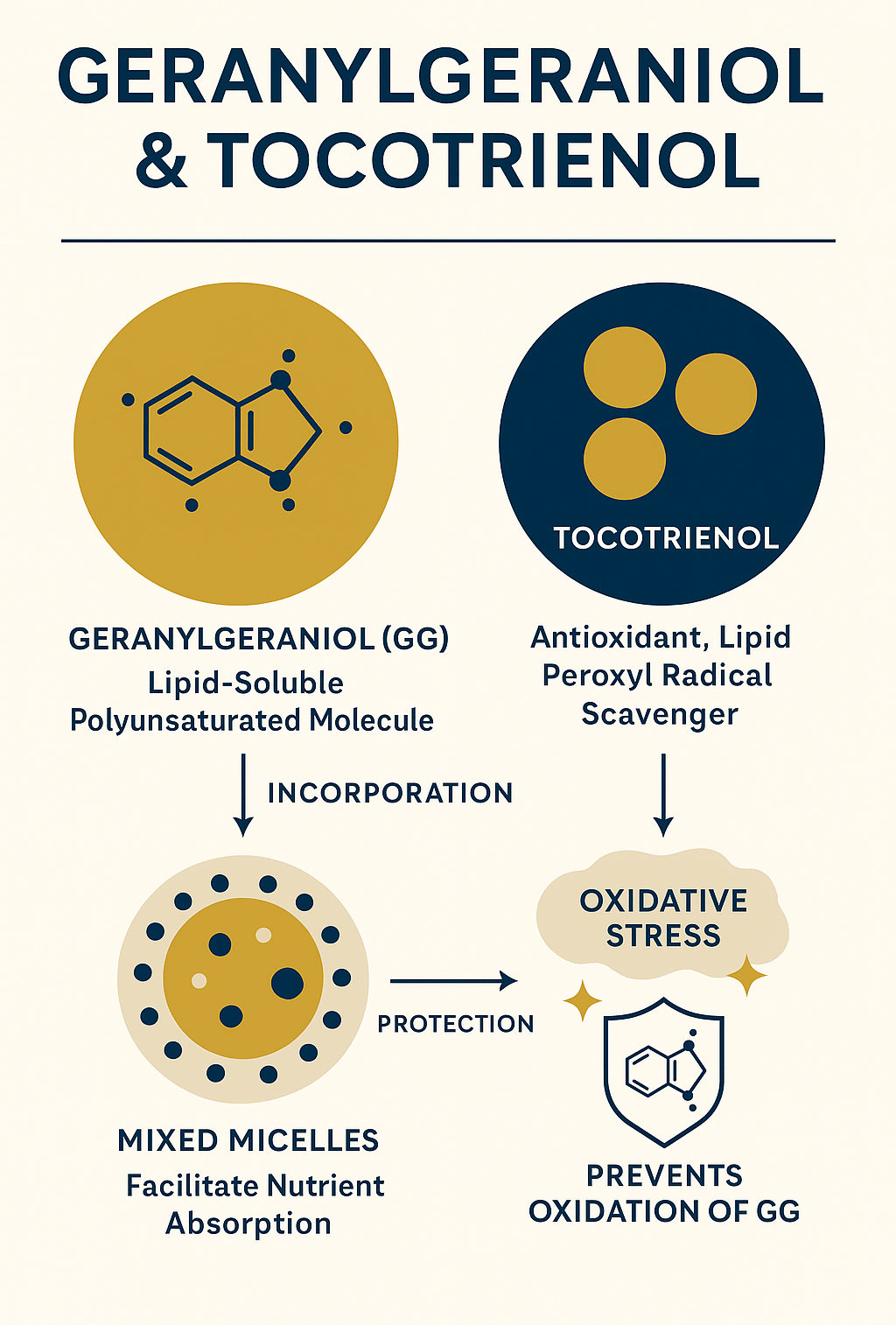Exploring Geranylgeraniol: A Nutritional Science Gem
Discover the critical roles of geranylgeraniol (GG), a naturally occurring diterpenoid alcohol in nutritional science. Learn about its potential benefits for mitochondrial health and fat-soluble nutrient absorption, and why this under-researched compound deserves attention.
ANTI-AGEINGCANCERCARDIOVASCULAR HEALTHLONGEVITYMETABOLIC HEALTHBRAIN HEALTHINFLAMMATIONBONE HEALTHMUSCLE HEALTHCELLULAR HEALTH
AlexanderJ
5/26/20253 min read


🧪 What Is Geranylgeraniol?
Chemically, GG is a 20-carbon unsaturated isoprenoid alcohol, fat-soluble and highly lipophilic. In the body, GG is converted into geranylgeranyl pyrophosphate (GGPP), which is used to prenylate key intracellular proteins. This lipid modification anchors proteins to cell membranes, allowing them to function properly.
Some of these prenylated proteins, including Rho, Rab, and Ras GTPases, are essential to:
Vesicle transport
Signal transduction
Cell structure and polarity
Mitochondrial dynamics
📚 Reference:
Casey PJ, Seabra MC. Protein prenyltransferases. J Biol Chem. 1996;271(10):5289–5292. PubMed
🧬 GG's Role in Nutrient Absorption - What We Know and What We Suspect
Let’s examine where GG might intersect with the absorption and transport of nutrients, particularly other lipophilic compounds such as annatto-derived tocotrienols.
1. ✅ Micelle Incorporation (Direct Participation)
GG does not form micelles itself, but as a lipid-soluble molecule, it is passively incorporated into mixed micelles in the small intestine.
These micelles, formed with the help of bile salts and phospholipids, are essential for the absorption of all fat-soluble nutrients, ncluding vitamin E, CoQ10, and tocotrienols.
📚 Reference:
Reboul E. Vitamin E Bioavailability: Mechanisms of Intestinal Absorption in the Spotlight 2017 Nov 22;6(4):95. PubMed
2. ⚙️ Chylomicron Export & Intracellular Transport
Once inside the intestinal cell (enterocyte), lipophilic nutrients are packaged into chylomicrons for lymphatic transport.
This packaging and export process relies on Rab GTPases, which require geranylgeranylation to function.
📚 Reference:
Seabra MC, et al. Rab geranylgeranyl transferase. J Biol Chem. 1992;267(20):14497–14503. PubMed
3. 🧩 Brush Border Dynamics via Rho Proteins
GG is also required to prenylate Rho and Rac proteins, which control the actin cytoskeleton of intestinal cells and maintain the microvilli, where nutrient absorption occurs.
📚 Reference:
Ridley AJ. Rho GTPases and cell migration. J Cell Sci. 2001;114(Pt 15):2713–2722. PubMed
4. 💧 Bile Production and Lipid Digestion
GG doesn’t directly regulate bile acid synthesis, but the mevalonate pathway affects membrane-associated vesicle trafficking, which may influence bile secretion indirectly.
📚 Reference:
Goldstein JL, Brown MS. Regulation of the mevalonate pathway. Nature. 1990;343(6257):425–430. PubMed
🌿 Can Tocotrienols Protect GG from Oxidative Stress?
Here’s a fascinating and highly plausible biological synergy - Geranylgeraniol may be protected from oxidative degradation by tocotrienols.
GG has a polyunsaturated structure with four double bonds, making it susceptible to peroxidation, especially in oxidative environments like membranes or during systemic inflammation.
At the same time, tocotrienols are potent lipid-phase antioxidants, significantly more effective than α-tocopherol in many settings, particularly in:
Preventing lipid peroxidation
Scavenging peroxyl radicals
Protecting polyunsaturated molecules embedded in membranes
If GG and tocotrienols co-localise in micelles, chylomicrons, or cellular membranes, it is very feasible that tocotrienols:
Prevent oxidative damage to GG
Preserve its biological activity
Extend its half-life in tissues exposed to oxidative stress
📚 Related research examples:
Yap WN et al. Tocotrienols suppress oxidative stress and lipid peroxidation in cellular models. Int J Mol Sci. 2021.
Sen CK, Khanna S. Tocotrienols in health and disease: the other half of vitamin E. Life Sci. 2006;78(18):2088–2098. PubMed
🧠 Implication: This natural synergy between tocotrienol and GG, as found in annatto, may reflect a co-evolved antioxidant–metabolic pairing, offering both stability and functionality in challenging environments like inflamed or oxidative tissues.
🔬 The Road Ahead - A Call for Research
The bottom line is: We don’t know everything GG can do - yet.
But we do know this:
It’s essential for a wide range of biological functions
It’s safe and naturally occurring
It’s involved in cellular systems that likely intersect with lipid absorption and redox balance
This is a scientific frontier worth exploring, especially given the promising role that tocotrienols and GG may play in the prevention and management of chronic diseases, including cancer, cardiovascular disease, and neurodegeneration.
✨ Final Thoughts
Geranylgeraniol may not be a celebrity nutrient yet, but it might just be one of the most quietly powerful players in the field of integrative health. As research expands, we anticipate that GG’s role will grow from silent supporter to spotlight contender.
At Natural Health Connect, we continue to follow the science and celebrate the potential of nature’s lesser-known molecules, because sometimes, the key to better health isn’t louder, it's deeper. Check out our newsletter archive and subscribe to our Newsletters.
